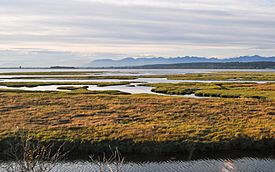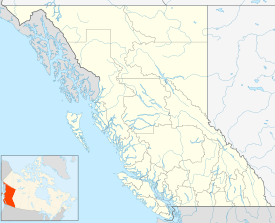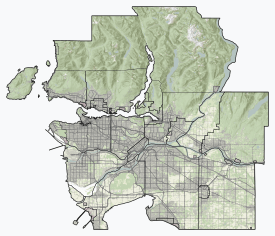Boundary Bay Wildlife Management Area facts for kids
Quick facts for kids Boundary Bay Wildlife Management Area |
|
|---|---|
|
IUCN Category IV (Habitat/Species Management Area)
|
|

Tidal flats of Mud Bay
|
|
| Location | Boundary Bay, British Columbia, Canada |
| Area | 11,470 ha (44.3 sq mi) |
| Designation | Wildlife Management Area |
| Established | 21 June 1995 |
| Governing body | FLNRORD |
The Boundary Bay Wildlife Management Area is a special protected area in British Columbia, Canada. It covers the entire Canadian part of Boundary Bay in the Lower Mainland. This area was created on June 21, 1995, by the British Columbia government. Its main goal is to protect important homes for migratory birds (birds that travel long distances) and local fish and marine mammals. It is also part of a bigger protected wetland called the Fraser River Delta Ramsar Site.
What is Boundary Bay?
This wildlife management area includes all of Boundary Bay. This bay is a shallow part of the Salish Sea. It sits right on the border between the Canadian province of British Columbia and the U.S. state of Washington.
The northeastern part of the bay is called Mud Bay. It gets its name from the large mudflats found there. This area is super important because it has many different kinds of plants and animals. It is also very good at producing a lot of life, which means it's a healthy ecosystem.
The management area also protects the places where the Serpentine and Nicomeki rivers meet the bay. Both of these rivers flow into Mud Bay from the northeast.
Who Lives in Boundary Bay?
The areas where the land meets the water, like the salt marshes and mudflats, are home to many plants. You can find sea asparagus and different types of grasses growing here.
Many bird species live in or visit the Boundary Bay Wildlife Management Area. Some common ones include the American wigeon, great blue heron, western sandpiper, rough-legged hawk, northern harrier, bald eagle, and barn owl.
The bay is also a great place for marine animals. A large group of harbour seals lives here. Sometimes, you might even see grey whales and orcas visiting. The bay is also a crucial spot for fish like salmon and Pacific herring to lay their eggs and find food.



